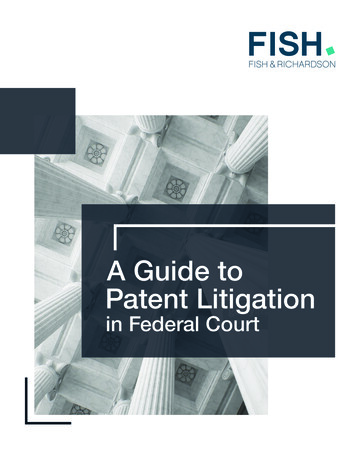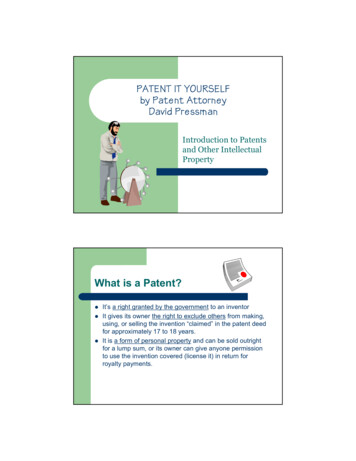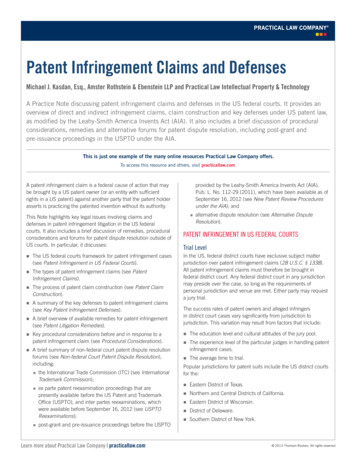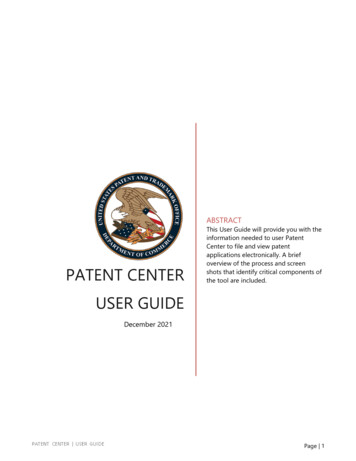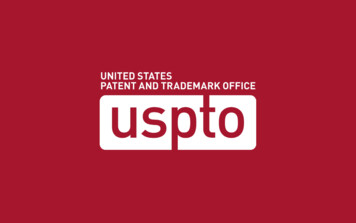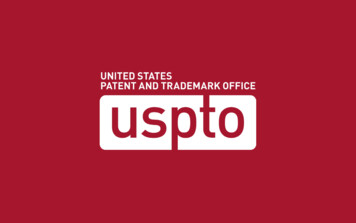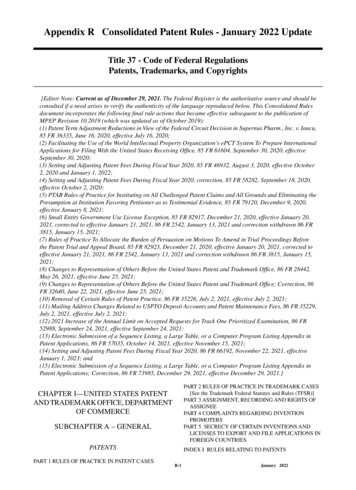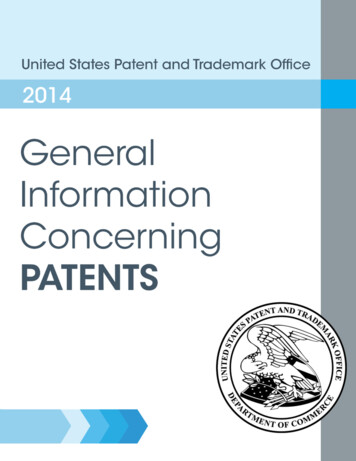
Transcription
The United States Patent and Trademark Officei
The United States Patent and Trademark Officeii
The United States Patent and Trademark OfficeContents Functions of the United States Patent and Trademark Office . . . . . . . . . . . . . . . . . . . . . 1 Patents, Trademarks, Servicemarks, and Copyrights . . . . . . . . . . . . . . . . . . . . . . . . . . . . . . 1What is a Patent? . . . . . . . . . . . . . . . . . . . . . . . . . . . . . . . . . . . . . . . . . . . . . . . . . . . . . . . . . . . . . . . . 1What Is a Trademark or Servicemark?. . . . . . . . . . . . . . . . . . . . . . . . . . . . . . . . . . . . . . . . . . . 2What is a Copyright?. . . . . . . . . . . . . . . . . . . . . . . . . . . . . . . . . . . . . . . . . . . . . . . . . . . . . . . . . . . . 2 Patent Laws . . . . . . . . . . . . . . . . . . . . . . . . . . . . . . . . . . . . . . . . . . . . . . . . . . . . . . . . . . . . . . . . . . . . . . . . 2 What Can Be Patented . . . . . . . . . . . . . . . . . . . . . . . . . . . . . . . . . . . . . . . . . . . . . . . . . . . . . . . . . . . . 2 Novelty and Nonobviousness,Conditions for Obtaining a . . . . . . . . . . . . . . . . . . . . . . 3Patent The United StatesPatent and Trademark Office . . . . . . . . . . . . . . . . . . . . . . . . . . . . . . . . . . 4 General Informationand Correspondence . . . . . . . . . . . . . . . . . . . . . . . . . . . . . . . . . . . . . . 5 Public Search Facility and Patent and Trademark Resource . . . . . . . . . . . . . . . . . . . . 6Centers Attorneys and Agents . . . . . . . . . . . . . . . . . . . . . . . . . . . . . . . . . . . . . . . . . . . . . . . . . . . . . . . . . . . . . . 7 Who May Apply for a Patent . . . . . . . . . . . . . . . . . . . . . . . . . . . . . . . . . . . . . . . . . . . . . . . . . . . . . . . 8 Independent Inventor Resources . . . . . . . . . . . . . . . . . . . . . . . . . . . . . . . . . . . . . . . . . . . . . . . . . . 8 Application for Patent . . . . . . . . . . . . . . . . . . . . . . . . . . . . . . . . . . . . . . . . . . . . . . . . . . . . . . . . . . . . . 9Nonprovisional Application for a Patent. . . . . . . . . . . . . . . . . . . . . . . . . . . . . . . . . . . . . . . . 9Provisional Application for a Patent . . . . . . . . . . . . . . . . . . . . . . . . . . . . . . . . . . . . . . . . . . . . 11Publication of Patent Applications . . . . . . . . . . . . . . . . . . . . . . . . . . . . . . . . . . . . . . . . . . . . . 11 File Your Application Electronically Using EFS-Web . . . . . . . . . . . . . . . . . . . . . . . . . . . . . . 12 Oath or Declaration, Signature . . . . . . . . . . . . . . . . . . . . . . . . . . . . . . . . . . . . . . . . . . . . . . . . . . .13 Filing, Search, and Examination Fees . . . . . . . . . . . . . . . . . . . . . . . . . . . . . . . . . . . . . . . . . . . . .13 Specification (Description and Claims) . . . . . . . . . . . . . . . . . . . . . . . . . . . . . . . . . . . . . . . . . 14iii
The United States Patent and Trademark Office Drawing. . . . . . . . . . . . . . . . . . . . . . . . . . . . . . . . . . . . . . . . . . . . . . . . . . . . . . . . . . . . . . . . . . . . . . . . . . . . . . . . . . . . 15Standards for Drawings . . . . . . . . . . . . . . . . . . . . . . . . . . . . . . . . . . . . . . . . . . . . . . . . . . . . . . . . . . . . . . . . 16. . . . . . . . . . . . . . . . . . . . . . . . . . . . . . . . . . . . . . . . . . . . . . . . . . . . . . . 20Models, Exhibits, and Specimens Examination of Applications and Proceedings in the United . . . . . . . . . . . . . . . . . . . . . . . . . . . 20States Patent and Trademark OfficeRestrictions . . . . . . . . . . . . . . . . . . . . . . . . . . . . . . . . . . . . . . . . . . . . . . . . . . . . . . . . . . . . . . . . . . . . . . . . . . . . . 21Office Action . . . . . . . . . . . . . . . . . . . . . . . . . . . . . . . . . . . . . . . . . . . . . . . . . . . . . . . . . . . . . . . . . . . . . . . . . . . . 21Applicant’s Reply . . . . . . . . . . . . . . . . . . . . . . . . . . . . . . . . . . . . . . . . . . . . . . . . . . . . . . . . . . . . . . . . . . . . . . . 21Final Rejections . . . . . . . . . . . . . . . . . . . . . . . . . . . . . . . . . . . . . . . . . . . . . . . . . . . . . . . . . . . . . . . . . . . . . . . . . 22Amendments to Application . . . . . . . . . . . . . . . . . . . . . . . . . . . . . . . . . . . . . . . . . . . . . . . . . . . . . . . . . . . 22 Time for Reply and Abandonment . . . . . . . . . . . . . . . . . . . . . . . . . . . . . . . . . . . . . . . . . . . . . . . . . . . . . . . 23 Appeal to the Patent Trial and Appeal Board and to the Courts . . . . . . . . . . . . . . . . . . . . . . . 23 Allowance and Issue of Patent . . . . . . . . . . . . . . . . . . . . . . . . . . . . . . . . . . . . . . . . . . . . . . . . . . . . . . . . . . . 23 Patent Term Extension and Adjustment. . . . . . . . . . . . . . . . . . . . . . . . . . . . . . . . . . . . . . . . . . . . . . . . . . . 24 Nature of Patent and Patent Rights . . . . . . . . . . . . . . . . . . . . . . . . . . . . . . . . . . . . . . . . . . . . . . . . . . . . . . 24. MaintenanceFees . . . . . . . . . . . . . . . . . . . . . . . . . . . . . . . . . . . . . . . . . . . . . . . . . . . . . . . . . . . . . . . . . . . . . . . . 25 Correction of Patents . . . . . . . . . . . . . . . . . . . . . . . . . . . . . . . . . . . . . . . . . . . . . . . . . . . . . . . . . . . . . . . . . . . . . 25 Assignments and Licenses. . . . . . . . . . . . . . . . . . . . . . . . . . . . . . . . . . . . . . . . . . . . . . . . . . . . . . . . . . . . . . . . 26Recording of Assignments . . . . . . . . . . . . . . . . . . . . . . . . . . . . . . . . . . . . . . . . . . . . . . . . . . . . . . . . . . . . . 26Joint Ownership . . . . . . . . . . . . . . . . . . . . . . . . . . . . . . . . . . . . . . . . . . . . . . . . . . . . . . . . . . . . . . . . . . . . . . . . 27 Infringement of Patents. . . . . . . . . . . . . . . . . . . . . . . . . . . . . . . . . . . . . . . . . . . . . . . . . . . . . . . . . . . . . . . . . . . 27 Patent Marking and Patent Pending . . . . . . . . . . . . . . . . . . . . . . . . . . . . . . . . . . . . . . . . . . . . . . . . . . . . . 27 Design Patents . . . . . . . . . . . . . . . . . . . . . . . . . . . . . . . . . . . . . . . . . . . . . . . . . . . . . . . . . . . . . . . . . . . . . . . . . . . . 28 Plant Patents . . . . . . . . . . . . . . . . . . . . . . . . . . . . . . . . . . . . . . . . . . . . . . . . . . . . . . . . . . . . . . . . . . . . . . . . . . . . . . 28 Treaties and Foreign Patents. . . . . . . . . . . . . . . . . . . . . . . . . . . . . . . . . . . . . . . . . . . . . . . . . . . . . . . . . . . . . . 29 Foreign Applicants for U.S. Patents . . . . . . . . . . . . . . . . . . . . . . . . . . . . . . . . . . . . . . . . . . . . . . . . . . . . . . . 30iv
The United States Patent and Trademark OfficeFunctions of the United States Patent and Trademark OfficeThe United States Patent and Trademark Office (USPTO or Office) is an agency of the U.S. Department ofCommerce. The role of the USPTO is to grant patents for the protection of inventions and to register trademarks.It serves the interests of inventors and businesses with respect to their inventions and corporate products, andservice identifications. It also advises and assists the President of the United States, the Secretary of Commerce,the bureaus and offices of the Department of Commerce, and other agencies of the government in mattersinvolving all domestic and global aspects of “intellectual property.” Through the preservation, classification, anddissemination of patent information, the Office promotes the industrial and technological progress of the nationand strengthens the economy.In discharging its patent related duties, the USPTO examines applications and grants patents on inventions whenapplicants are entitled to them; it publishes and disseminates patent information, records assignments of patents,maintains search files of U.S. and foreign patents, and maintains a search room for public use in examiningissued patents and records. The Office supplies copies of patents and official records to the public. It providestraining to practitioners as to requirements of the patent statutes and regulations, and it publishes the Manualof Patent Examining Procedure to elucidate these. Similar functions are performed relating to trademarks. Byprotecting intellectual endeavors and encouraging technological progress, the USPTO seeks to preserve theUnited States’ technological edge, which is key to our current and future competitiveness. The USPTO alsodisseminates patent and trademark information that promotes an understanding of intellectual property protectionand facilitates the development and sharing of new technologies worldwide.Patents, Trademarks, Servicemarks, and CopyrightsSome people confuse patents, copyrights, and trademarks. Although there may be some similarities among thesekinds of intellectual property protection, they are different and serve different purposes.What Is a Patent?A patent for an invention is the grant of a property right to the inventor, issued by the United States Patent andTrademark Office. Generally, the term of a new patent is 20 years from the date on which the application for thepatent was filed in the United States or, in special cases, from the date an earlier related application was filed,subject to the payment of maintenance fees. U.S. patent grants are effective only within the United States, U.S.territories, and U.S. possessions. Under certain circumstances, patent term extensions or adjustments may beavailable.The right conferred by the patent grant is, in the language of the statute and of the grant itself, “the right toexclude others from making, using, offering for sale, or selling” the invention in the United States or “importing”the invention into the United States. What is granted is not the right to make, use, offer for sale, sell or import,but the right to exclude others from making, using, offering for sale, selling or importing the invention. Once apatent is issued, the patentee must enforce the patent without aid of the USPTO.There are three types of patents:1) Utility patents may be granted to anyone who invents or discovers any new and useful process,machine, article of manufacture, or composition of matter, or any new and useful improvement thereof;2) Design patents may be granted to anyone who invents a new, original, and ornamental design foran article of manufacture; and3) Plant patents may be granted to anyone who invents or discovers and asexually reproduces anydistinct and new variety of plant.1
The United States Patent and Trademark OfficeWhat Is a Trademark or Servicemark?A trademark is a word, name, symbol, or device that is used in trade with goods to indicate the source of thegoods and to distinguish them from the goods of others. A servicemark is the same as a trademark except that itidentifies and distinguishes the source of a service rather than a product. The terms “trademark” and “mark” arecommonly used to refer to both trademarks and servicemarks.Trademark rights may be used to prevent others from using a confusingly similar mark, but not to preventothers from making the same goods or from selling the same goods or services under a clearly different mark.Trademarks that are used in interstate or foreign commerce may be registered with the USPTO. The registrationprocedure for trademarks and general information concerning trademarks can be found in the separate bookentitled “Basic Facts about Trademarks.”What Is a Copyright?Copyright is a form of protection provided to the authors of “original works of authorship” including literary,dramatic, musical, artistic, and certain other intellectual works, both published and unpublished. The 1976Copyright Act generally gives the owner of copyright the exclusive right to reproduce the copyrighted work,to prepare derivative works, to distribute copies or phonorecords of the copyrighted work, to perform thecopyrighted work publicly, or to display the copyrighted work publicly.The copyright protects the form of expression rather than the subject matter of the writing. For example, adescription of a machine could be copyrighted, but this would only prevent others from copying the description;it would not prevent others from writing a description of their own or from making and using the machine.Copyrights are registered by the Copyright Office of the Library of Congress.Patent LawsThe Constitution of the United States gives Congress the power to enact laws relating to patents, in Article I,section 8, which reads “Congress shall have power . . . to promote the progress of science and useful arts, bysecuring for limited times to authors and inventors the exclusive right to their respective writings and discoveries.”Under this power Congress has from time to time enacted various laws relating to patents. The first patent lawwas enacted in 1790. On July 19, 1952, the patent laws were codified in Title 35, United States Code. TheLeahy-Smith America Invents Act, Public Law 112-29, 125 Stat. 284 (September 16, 2011) revised Title 35effective March 16, 2013 to change the U.S. patent system from a “first to invent” system to a “first inventor tofile” system.The patent law specifies the subject matter for which a patent may be obtained and the conditions forpatentability. The law establishes the United States Patent and Trademark Office to administer the law relating tothe granting of patents and contains various other provisions relating to patents.What Can Be PatentedThe patent law specifies the general field of subject matter that can be patented and the conditions under whicha patent may be obtained.In the language of the statute, any person who “invents or discovers any new and useful process, machine,manufacture, or composition of matter, or any new and useful improvement thereof, may obtain a patent,”subject to the conditions and requirements of the law. The word “process” is defined by law as a process, act, ormethod, and primarily includes industrial or technical processes. The term “machine” used in the statute needs noexplanation. The term “manufacture” refers to articles that are made, and includes all manufactured articles. Theterm “composition of matter” relates to chemical compositions and may include mixtures of ingredients as wellas new chemical compounds. These classes of subject matter taken together include practically everything that is2
The United States Patent and Trademark Officemade by man and the processes for making the products.The Atomic Energy Act of 1954 excludes the patenting of inventions useful solely in the utilization of specialnuclear material or atomic energy in an atomic weapon. See 42 U.S.C. 2181(a).The patent law specifies that the subject matter must be “useful.” The term “useful” in this connection refers to thecondition that the subject matter has a useful purpose and also includes operativeness, that is, a machine whichwill not operate to perform the intended purpose would not be called useful, and therefore would not be granteda patent.Interpretations of the statute by the courts have defined the limits of the field of subject matter that can bepatented, thus it has been held that the laws of nature, physical phenomena, and abstract ideas are notpatentable subject matter.A patent cannot be obtained upon a mere idea or suggestion. The patent is granted upon the new machine,manufacture, etc., as has been said, and not upon the idea or suggestion of the new machine. A completedescription of the actual machine or other subject matter for which a patent is sought is required.Novelty and Nonobviousness, Conditions for Obtaining a PatentIn order for an invention to be patentable it must be new as defined in the patent law, which provides that aninvention cannot be patented if:“(1) the claimed invention was patented, described in a printed publication, or in public use, on sale, orotherwise available to the public before the effective filing date of the claimed invention” or“(2) the claimed invention was described in a patent issued [by the U.S.] or in an application for patentpublished or deemed published [by the U.S.], in which the patent or application, as the case may be,names another inventor and was effectively filed before the effective filing date of the claimed invention.”There are certain limited patent law exceptions to patent prohibitions (1) and (2) above. Notably, an exceptionmay apply to a “disclosure made 1 year or less before the effective filing date of the claimed invention,” butonly if “the disclosure was made by the inventor or joint inventor or by another who obtained the subject matterdisclosed from the inventor or a joint inventor.”In patent prohibition (1), the term “otherwise available to the public” refers to other types of disclosures of theclaimed invention such as, for example, an oral presentation at a scientific meeting, a demonstration at a tradeshow, a lecture or speech, a statement made on a radio talk show, a YouTube video, or a website or other online material.Effective filing date of the claimed invention: This term appears in patent prohibitions (1) and (2). For a U.S.nonprovisional patent application that is the first application containing the claimed subject matter, the term“effective filing date of the claimed invention” means the actual filing date of the U.S. nonprovisional patentapplication. For a U.S. nonprovisional application that claims the benefit of a corresponding prior-filed U.S.provisional application, “effective filing date of the claimed invention” can be the filing date of the prior-filedprovisional application provided the provisional application sufficiently describes the claimed invention. Similarly,for a U.S. nonprovisional application that is a continuation or division of a prior-filed U.S. nonprovisionalapplication, “effective filing date of the claimed invention” can be the filing date of the prior filed nonprovisionalapplication that sufficiently describes the claimed invention. Finally, “effective filing date of the claimed invention”may be the filing date of a prior-filed foreign patent application to which foreign priority is claimed provided theforeign patent application sufficiently describes the claimed invention.Even if the subject matter sought to be patented is not exactly shown by the prior art, and involves one or moredifferences over the most nearly similar thing already known, a patent may still be refused if the differenceswould be obvious. The subject matter sought to be patented must be sufficiently different from what has been3
The United States Patent and Trademark Officeused or described before that it may be said to be nonobvious to a person having ordinary skill in the area oftechnology related to the invention. For example, the substitution of one color for another, or changes in size, areordinarily not patentable.The United States Patent and Trademark OfficeCongress established the United States Patent and Trademark Office to issue patents on behalf of thegovernment. The Patent Office as a distinct bureau dates from the year 1802 when a separate official in theDepartment of State, who became known as “Superintendent of Patents,” was placed in charge of patents. Therevision of the patent laws enacted in 1836 reorganized the Patent Office and designated the official in chargeas Commissioner of Patents. The Patent Office remained in the Department of State until 1849 when it wastransferred to the Department of Interior. In 1925 it was transferred to the Department of Commerce where it istoday. The name of the Patent Office was changed to the Patent and Trademark Office in 1975 and changed tothe United States Patent and Trademark Office in 2000.The USPTO administers the patent laws as they relate to the granting of patents for inventions, and performsother duties relating to patents. Applications for patents are examined to determine if the applicants are entitledto patents under the law and patents are granted when applicants are so entitled. The USPTO publishes issuedpatents and most patent applications 18 months from the earliest effective application filing date, and makesvarious other publications concerning patents. The USPTO also records assignments of patents, maintains asearch room for the use of the public to examine issued patents and records, and supplies copies of records andother papers, and the like. Similar functions are performed with respect to the registration of trademarks. TheUSPTO has no jurisdiction over questions of infringement and the enforcement of patents.The head of the Office is the Under Secretary of Commerce for Intellectual Property and Director of the UnitedStates Patent and Trademark Office (Director). The Director’s staff includes the Deputy Under Secretary ofCommerce and Deputy Director of the USPTO, the Commissioner for Patents, the Commissioner for Trademarks,and other officials. As head of the Office, the Director superintends or performs all duties respecting the grantingand issuing of patents and the registration of trademarks; exercises general supervision over the entire workof the USPTO; prescribes the rules, subject to the approval of the Secretary of Commerce, for the conduct ofproceedings in the USPTO, and for recognition of attorneys and agents; decides various questions broughtbefore the Office by petition as prescribed by the rules; and performs other duties necessary and required for theadministration of the United States Patent and Trademark Office.The work of examining applications for patents is divided among a number of examining technology centers(TCs), each TC having jurisdiction over certain assigned fields of technology. Each TC is headed by groupdirectors and staffed by examiners and support staff. The examiners review applications for patents anddetermine whether patents can be granted. An appeal can be taken to the Patent Trial and Appeal Board fromtheir decisions refusing to grant a patent, and a review by the Director of the USPTO may be had on othermatters by petition. In addition to the examining TCs, other offices perform various services, such as receivingand distributing mail, receiving new applications, handling sales of printed copies of patents, making copies ofrecords, inspecting drawings, and recording assignments.At present, the USPTO has over 11,000 employees, of whom about three quarters are examiners and others withtechnical and legal training. Patent applications are received at the rate of over 500,000 per year.Effective November 15, 2011, any regular nonprovisional utility application filed by mail or hand-delivery willrequire payment of an additional 400 fee called the “non-electronic filing fee,” which is reduced by 50 percent(to 200) for applicants that qualify for small entity status under 37 CFR 1.27(a). The 75 percent micro entitydiscount does not apply to the non-electronic filing fee and consequently the non-electronic filing fee is also 200for applicants that qualify for micro entity status under 37 CFR 1.29(a) or (d). This fee is required by Section10(h) of the Leahy-Smith America Invents Act, Public Law 112-29 (Sept. 16, 2011; 125 Stat. 284). The onlyway to avoid having to pay the additional 400 non-electronic filing fee is to file the regular nonprovisionalutility patent application via EFS-Web. Design, plant, and provisional applications are not subject to theadditional non-electronic filing fee and may continue to be filed by mail or hand-delivery without additional4
The United States Patent and Trademark Officecharge. See the information available at www.uspto.gov/patents/process/file/efs/index.jsp. Any questionsregarding filing applications via EFS-Web should be directed to the Electronic Business Center at 866-217-9197.General Information and CorrespondenceAll business with the United States Patent and Trademark Office should be transacted in writing. Regularnonprovisional utility applications must be filed via EFS-Web in order to avoid the additional 400 non-electronicfiling fee.Other patent correspondence, including design, plant, and provisional application filings, as well ascorrespondence filed in a nonprovisional application after the application filing date (known as “follow-on”correspondence), can still be filed by mail or hand-delivery without incurring the 400 non-electronic filing fee.Such other correspondence relating to patent matters should be addressed toCOMMISSIONER FOR PATENTSP.O. Box 1450Alexandria, VA 22313-1450when sent by mail via the United States Postal Service. If a mail stop is appropriate, the mail stop should also beused.Mail addressed to different mail stops should be mailed separately to ensure proper routing. For example, afterfinal correspondence should be mailed toMail Stop AF, Commissioner for PatentsP.O. Box 1450Alexandria, VA 22313-1450and assignments should be mailed toMail Stop Assignment Recordation ServicesDirector of the U.S. Patent and Trademark OfficeP.O. Box 1450; Alexandria, VA 22313-1450Correspondents should be sure to include their full return addresses, including zip codes. The principal locationof the USPTO is 600 Dulany Street, Alexandria, Va. The personal presence of applicants at the USPTO isunnecessary.You do not have to be a Registered eFiler to file a patent application via EFS-Web. However, unless you area Registered eFiler, you must not attempt to file follow-on correspondence via EFS-Web, because UnregisteredeFilers are not permitted to file follow-on correspondence via EFS-Web. Follow-on correspondence filed byanyone other than an EFS-Web Registered eFiler must be sent by mail or hand-delivered to the address specifiedin the paragraph above.Applicants and attorneys are required to conduct their business with decorum and courtesy. Papers presented inviolation of this requirement will be returned.Separate letters (but not necessarily in separate envelopes) should be written for each distinct subject of inquiry,such as assignments, payments, orders for printed copies of patents, orders for copies of records, and requestsfor other services. None of these inquiries should be included with letters responding to Office actions inapplications.When a letter concerns a patent application, the correspondent must include the application number (consistingof the series code and the serial number, e.g., 12/123,456) or the serial number and filing date assigned to thatapplication by the Office, or the international application number of the international application number of the5
The United States Patent and Trademark Officeinternational application. When a letter concerns a patent (other than for purposes of payment of a maintenancefee), it should include the name of the patentee, the title of the invention, the patent number, and the date ofissue.An order for a copy of an assignment should identify the reel and frame number where the assignment ordocument is recorded; otherwise, an additional charge is made for the time consumed in making the search forthe assignment.Applications for patents, which are not published or issued as patents, are not generally open to the public, andno information concerning them is released except on written authority of the applicant, his or her assignee,or his or her attorney, or when necessary to the conduct of the business of the USPTO. Patent applicationpublications and patents and related records, including records of any decisions, the records of assignmentsother than those relating to assignments of unpublished patent applications, patent applications that are reliedupon for priority in a patent application publication or patent, books, and other records and papers in the Officeare open to the public. They may be inspected in the USPTO Search Room, or copies may be ordered.The Office cannot respond to inquiries concerning the novelty and patentability of an invention prior to thefiling of an application; give advice as to possible infringement of a patent; advise of the propriety of filing anapplication; respond to inquiries as to whether, or to whom, any alleged invention has been patented; act asan expounder of the patent law or as counselor for individuals, except in deciding questions arising before it inregularly filed cases. Information of a general nature may be furnished either directly or by supplying or callingattention to an appropriate publication.Public Search Facility and Patent and Trademark Resource CentersThe Scientific and Technical Information Center of the United States Patent and Trademark Office located at1D58 Remsen, 400 Dulany Street, Alexandria, Va., has available for public use over 120,000 volumes ofscientific and technical books in various languages, about 90,000 bound volumes of periodicals devoted toscience and technology, the official journals of 77 foreign patent organizations, and over 40 million foreignpatents on paper, microfilm, microfiche, and CD-ROM. The Scientific and Technical Information Center is open tothe public from 8 a.m. to 5 p.m., Monday through Friday except federal holidays.The Public Search Facility located at Madison East, First Floor, 600 Dulany Street, Alexandria, Va., is where thepublic may search and examine U.S. patents granted since 1790 using state of the art computer workstations.A complete patent backfile in numeric sequence is available on microfilm or in optical disc format. OfficialGazettes, Annual Indexes (of inventors), the Manual of Classification and its subject matter index, and othersearch aids are available in various formats. Patent assignment records of transactions affecting the ownership ofpatents, microfilmed deeds, and indexes are also available.The Public Search Facility is open from 8 a.m. to 8 p.m. Monday through Fr
Trademark Office. Generally, the term of a new patent is 20 years from the date on which the application for the patent was filed in the United States or, in special cases, from the date an earlier related application was filed, subject to the payment of maintenance fees. U.S. patent grants are effective only within the United States, U.S.


